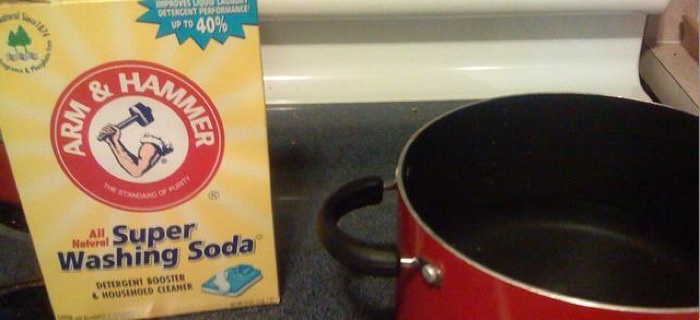All About Washing Soda

We're always trying for two things around here: healthier living. and saving money!
It's why we go through so much vinegar and baking soda. We use vinegar to clean our unfinished wood floors and our windows, as well as in the laundry, and we use baking soda in the laundry and elsewhere.
I read about using washing soda as a hand dishwashing agent, and of course, I had to try it. As it happens, we have a HUGE bag of washing soda, aka soda ash, in the basement. I used it for dyeing cotton, and it was a component in the dishwasher powder I make. So we got a jarful out of the basement and conducted some quick dishwashing tests.
We found that it does work for handwashing dishes, but it takes a LOT of water to rinse. It also leaves a film of grease on the water itself--it's a good degreaser, but the grease has to go somewhere. The best results we got were on pans with some burnt-on grease. Right now we can only recommend it as an emergency dang-we're-out-of-dish-soap measure.

Last night we conducted a test of how well it would clean the bane of my existence, the stove pans. [Ed: this is back when I had stove pans. I've since upgraded to a flat top stove.] I put a heaping soup spoon of washing soda in very hot water and put the pan in to soak. To the top left is the "before" picture, and to the right is the "half-after" picture. John took a copper scrubber to half the pan, and you can see it removed the burned-on gunk quite well. He says he didn't have to scrub that hard, either. The big flaw in the experiment, of course, is that we didn't put a pan to soak in plain hot water as a control.

Washing soda is not only ideally suited for baked-on grime like stove pans, it can STRIP OLD FLOOR WAX AND PAINT! Yikes! Don't use it on anything you want to retain a shine, like waxed floors, painted walls, fiberglass and the like--anything with a finish, essentially.
Washing soda is caustic, and if you're going to have your hands in it for any length of time, wear gloves. It's also quite alkaline, which makes it a very effective water softener for laundering. Using it in hard water areas will cut down on the amount of laundry detergent you have to use.
And it's also a great descaler. We've successfully used it to remove gunk from the coffee maker. Use one tablespoonful for every 8 oz cup of water your maker holds. Be sure to rinse well! We usually run one "potsworth" of washing soda solution through the coffee maker and then one "potsworth" of vinegar water (half and half), and then a couple of pots of just plain water.
Lynn Siprelle is the founder of The New Homemaker.
